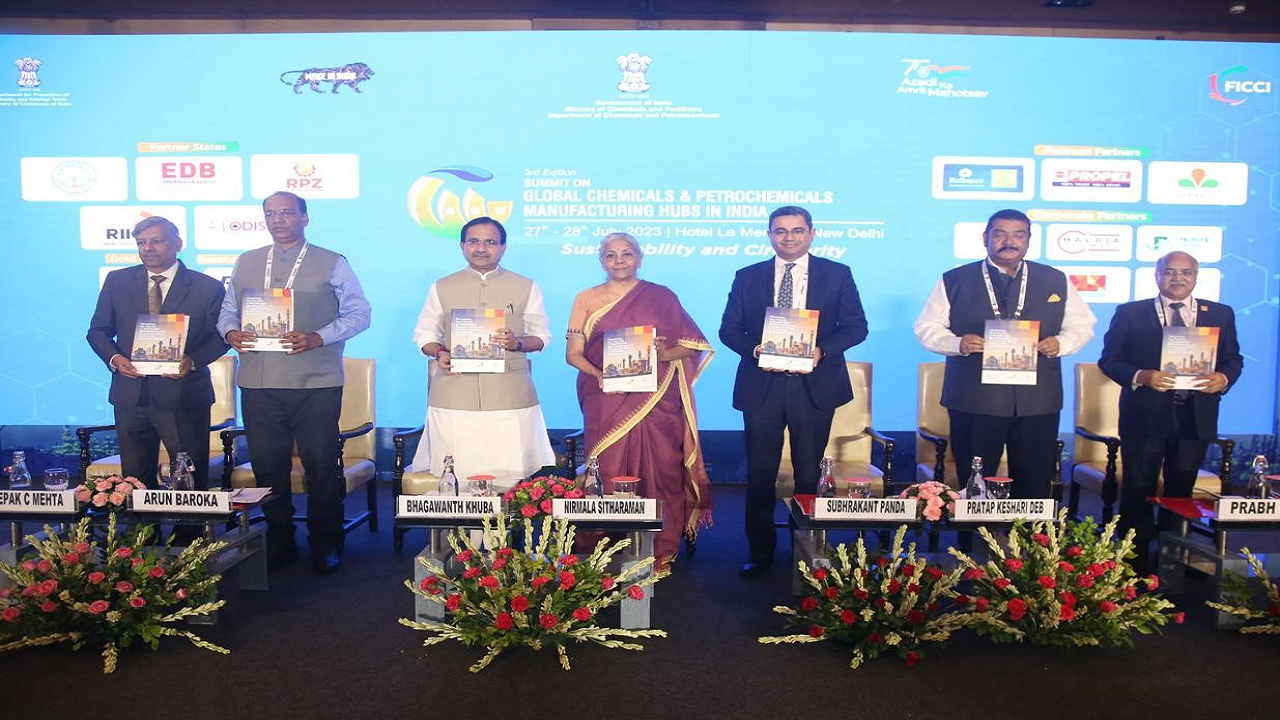
Today, Nirmala Sitharaman, the Minister of Finance and Corporate Affairs for the Government of India, expressed the significant potential of the Indian chemicals and petrochemicals sector, emphasizing its influence on various other industries within the economy. The minister highlighted that the sector's importance is evident from its production of a vast array of 80,000 products, spanning crucial fields such as agriculture, infrastructure, textiles, and packaging.
In line with the goal of establishing India as a prominent manufacturing hub, she disclosed the government's inclination to consider implementing the Production Linked Incentive (PLI) scheme specifically for the chemicals and petrochemicals industry.
During her speech at the '3rd Global Chemicals & Petrochemicals Manufacturing Hubs in India Summit' organized by FICCI, Sitharaman expressed India's ambitious goals of attaining energy independence by 2047 and reaching net zero emissions by 2070. She called upon the industry to actively participate in these objectives, emphasizing that every sector must contribute to achieving net zero emissions. Sitharaman underscored the government's strong commitment to green growth and emphasized the need for reducing carbon intensity, making it clear that each sector's involvement is crucial in this collective effort.
Finance Minister Sitharaman highlighted the challenges in the chemicals and petrochemicals sector, urging the industry to focus on crucial aspects such as sustainability, upskilling the workforce, adopting Industry 4.0 technologies, pollution control, and enhancing workforce skills. She acknowledged India's significant global impact with $9 billion in combined exports but also noted the rise in imports to $13.33 billion.
However, she expressed comfort with the situation, emphasizing the potential for domestic production to meet the import demands. Additionally, she encouraged the industry, including FICCI, to explore opportunities for transitioning towards a circular economy. The government pledged to carefully consider industry recommendations to ensure the sector's sustainability.
The Minister of Finance of India emphasized the impressive growth of the specialty chemicals market in India, predicting a 12% Compound Annual Growth Rate (CAGR) for the industry. She recognized the need for stronger support in the specialized chemicals sector, attributing its rise to India's strong process engineering capabilities, cost-effective manufacturing capacities, and skilled workforce.
Bhagwanth Khuba, the Minister of State for Chemicals & Petrochemicals and New & Renewable Energy, reaffirmed the government's dedication to creating a supportive ecosystem for the sector. Collaborative efforts with state governments to establish chemical parks and plastic parks are already in progress. The government is fostering industry-academia collaboration through Centers of Excellence and promoting skill development initiatives.
The sector's current market size is around $190 billion, with significant projected growth. It is anticipated to reach $300 billion by 2025 and a remarkable $1 trillion by 2040, presenting lucrative opportunities for the industry.
According to Pratap Keshari Deb, the Minister of Industries, MSME & Energy, Government of Odisha, the domestic chemicals sector is experiencing a steady growth rate of 8 percent. To maintain this growth trajectory for the next decade, the sector would require a substantial 40 percent increase in its capacity. The Odisha government is fully committed to supporting industries interested in establishing their operations within the state, offering necessary guidance and assistance throughout the process.
Arun Baroka, the Secretary (Chemicals & Petrochemicals) in the Department of Chemicals & Petrochemicals, Government of India, expressed optimism about India's potential to become a prominent global manufacturing hub. He attributed this positive outlook to the combination of policy reforms, rising demand, and continuous innovation within the industry. According to him, the evolving landscape of the sector is propelling the Indian chemicals and petrochemicals industry toward a new phase of growth, presenting various fresh opportunities.
Subhrakant Panda, President of FICCI, highlighted the impressive diversity of the Indian chemicals sector, boasting a wide array of 80,000 products that serve as crucial building blocks and raw materials for multiple industries. The sector has exhibited robust growth, surpassing 1.2 times the rate of GDP expansion. With its immense potential to generate employment opportunities and drive exports, the Indian chemicals industry is bolstered by domestic consumption and favorable government policies. India is regarded as an attractive destination for the chemicals sector, and it is projected to reach a substantial $1 trillion valuation by the year 2040, making a significant impact on the overall economy.
Deepak C Mehta, who serves as the Chairman of FICCI National Chemical Committee and is also the CMD of Deepak Nitrite Ltd, along with Prabh Das, the Chairman of FICCI Petrochemicals Committee and MD & CEO of HPCL-Mittal Energy Ltd, both offered their insights on the Indian chemicals and petrochemicals sector.

















